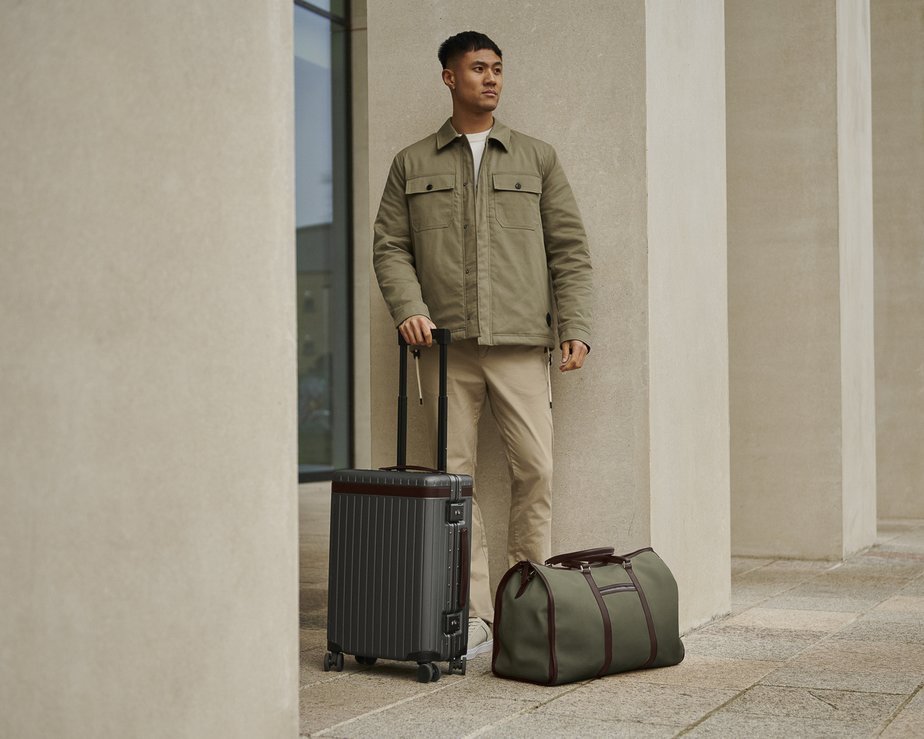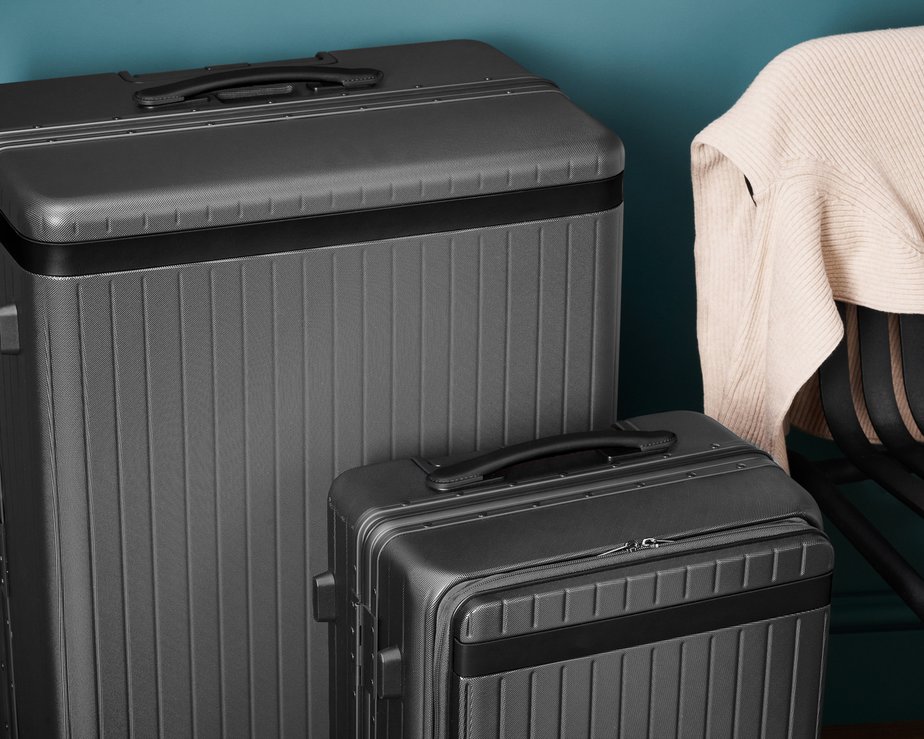Luggage might once have been an uninspiring albeit practical necessity, but today it has been elevated to the realm of fashionable accessories.
Essential luggage types
Published 2 years ago

There’s a myriad of types of luggage available on the market, making it difficult to decide which one is just right for you.
To save you the hassle, we’re charting the six main luggage styles and listing the pros and cons of each. Let’s begin.

Types of luggage
Luggage has come a long way since its 12th-century debut, when the Knights of Templar used custom-built wheeled cases to transport arms during the Crusades. The advent of stagecoaches, steamships, locomotives, motorised transport and aviation has driven its evolution in the modern era.
Numerous kinds of luggage now compete for consumer attention, each with unique pros and cons.
Carry-on
The name says it all: you carry this luggage with you onboard the aircraft and stow it in the overhead locker. The broad term encompasses all luggage styles, from suitcases to leather backpacks and everything in between.
A carry-on should generally measure less than 22” x 14” x 9” to comply with airline-imposed size restrictions. However, every carrier has different regulations, so it’s wise to check their website before you fly.
The other crucial consideration is weight. Airlines usually impose a weight restriction, which may or may not include your personal item (a small bag that slides under the seat).
Pros
For penny-pinchers, the big bonus is avoiding airline check-in fees, which add up over time. A carry-on bag also streamlines the arrival and departure process, as you no longer need to queue at the check-in desk or wait at the carousel. Moreover, you’ll never have to worry about lost luggage again and get a nimble, lightweight pack to whisk around town.
Cons
On the downside, limited space makes carry-on a struggle for habitual over-packers. With approximately 40 litres at your disposal, you’ll need to be washing clothes more often and forgo bulky items. Staying on top of airline luggage restrictions can also become a chore.

Check-in
Check-in luggage, as the name suggests, must be checked-in upon departure as it’s too bulky to squeeze into the overhead cabin. Once again, check-in luggage spans the full baggage spectrum — the term refers to size rather than style.
As a general rule, check-in bags should be no bigger than 62 linear inches, which is the combined length, width and depth. Most airlines impose a strict weight limit, though restrictions do vary. Some airlines (and cabin classes) allow two check-in pieces and/or more weight.
Pros
The main advantage is check-in luggage allows you to carry more. The average size of 60-80 litres lets you travel with a respectable wardrobe and abundant accessories, ideal for style-conscious wanderers, families, and tech heads. You also won’t have to lug it around the airport (at least not once it’s checked in).
Cons
However, you’ll have to pay extra for check-in luggage on most airlines and queue at the check-in counter and carousel. Large luggage is harder to carry around town — you may even need to seek help from hotel porters and taxi drivers as you go.

Hardside
Hardside luggage — AKA hard luggage or hard-shell luggage — refers to its sturdy, non-flexible shell.
The ideal exterior material is polycarbonate, a thermoplastic polymer famed for its lightweight nature and impressive durability. Cheaper ABS plastics provide less protection at a lower cost, while aluminium offers optimal strength with added weight and expense.
This rigid outer shell most commonly adorns most types of suitcases. You’ll occasionally see it on backpacks, usually specialist cameras or equipment bags.
Pros
The durable outer shell offers excellent protection against inevitable bumps in the road — not to mention mistreatment from time-stressed baggage handlers. The virtually-impermeable casing also offers ample waterproofing and is easy to wipe clean.
The clamp-close design doesn’t rely on zippers to keep these suitcase types shut, thus improving their longevity. Sleek aesthetics, hassle-free manoeuvrability (most have multi-directional wheels), and a stackable design enhance the appeal.
Cons
The major downside is that hard-side luggage isn’t malleable, making it impossible to compress into confined spaces. In addition, reckless handling may result in irreparable cracks and most lack exterior pockets. Check out The Carry-on X if you’re after an elegant hard-shell case with a handy exterior pocket.

Softside
Also referred to as soft or soft-shell luggage, soft-side luggage has malleable fabric in the outer shell to contort into confined spaces. Softside spans a multitude of designs, including suitcases, backpacks, duffel bags and weekenders.
Manufacturers typically use durable high-yield materials like woven nylon. Cordura nylon has a stylish woven-like texture and soft, abrasion-resistant properties, while ballistic nylon is glossier but tends to fray. Ripstop nylon is your best bet for a tough, weather-resistant —albeit less stylish —finish.
Pros
Unlike hard-side luggage, you can squeeze these pliable fabric-encased bags into tight spaces, such as overhead lockers or the gap beneath your bed. The stretchable nature lets you store more inside, and most models include handy exterior pockets. A lightweight design aids mobility and counts less towards airline weight restrictions. You could also argue that the soft exterior is more durable, as it’s impossible to crack or scratch.
Cons
However, the pliable outer fabric offers less protection than hard-shell, exposing your delicate electronics (or souvenirs) to damage. Shady characters can slice through the material to steal your possessions and its porous nature makes it vulnerable to stains. Moreover, soft-side luggage only has modest water resistance, so you’ll need to stay well away from the rain.

Duffel
The duffel bag is an affordable yet heavy-duty, soft-side luggage type, sold with or without wheels. Both types have a tough outer layer like ripstop nylon or canvas.
The wheeled variety tends to be bigger, and often includes an assortment of zippers, pockets and straps. Extra compartments and multi-directional wheels make it a functional travel companion.
Non-wheeled duffels are somewhat simplistic, featuring nothing more than a top zipper, carry handle and shoulder straps. Originally designed for military use, the trusty cylindrical-shaped duffel is a hit among outdoorsy types — think gym sessions and camping trips.
Pros
Roller duffels provide a happy compromise between hard-side suitcases and non-wheeled duffels. You get the convenience of multi-directional wheels and ample compartments to stash your essentials.
The traditional cylinder-styled duffel, on the other hand, has a malleable design to squish into confined spaces. Abundant room allows you to carry equipment like diving and climbing gear.
Cons
As they’re more rigid, the wheeled duffel won’t squeeze into tight spaces. Roller duffels are also cumbersome to carry on cobblestone roads or up and down stairs.
A standard duffel generally has one compartment, which can make organisation a challenge. Although they’re fine to lug short stints, long-distance jaunts lead to sore shoulders and arms. Also, most duffels feature a rugged, functional design, which can be less appealing to style-conscious travellers.

Weekend bag
The weekend bag, or weekender, is a slick bag designed for short trips away. While the rugged canvas-woven duffel prioritises function over fashion, a smaller weekender boasts sleek aesthetics to appeal to fashionable urbanites.
The top-end options come in high-quality leather like nubuck or Vachetta leather, though more affordable materials are available. Due to their smaller stature, these stylish soft-side bags comply with carry-on restrictions.
Pros
Compact, stylish, and malleable by design, the weekend bag is ideal for quick, hassle-free stints away. Most come with interior pockets to optimise organisation and a stain-resistant exterior to protect against spills.
Cons
The big drawback is limited space. The weekend bag, as the name implies, won’t hold more than a few days’ worth of clothes. While integrated shoulder straps improve comfort, the bags can still be difficult to carry around for extended periods.

Which luggage style is for you?
So which type of luggage is best for you? Let’s identify the ideal option by summarising the information above.
First up: carry-on versus check-in luggage. If you loathe queuing up at the carousel and paying exorbitant check-in luggage fees, opt for an agile carry-on bag — be it a backpack, suitcase, duffel or weekender. Heavy packers will find check-in baggage worth the hassle and expense.
As for the soft-side versus hard-side debate? Hardside luggage appeals to those with delicate items like electronics or handcrafted goods. Spring for soft-side if you’re not stressed about breakages and like its malleable, lightweight design.
Wheeled duffel bags offer an affordable alternative for travellers seeking roller suitcase-level convenience with more external pockets and a pliable outer shell. The standard, cylindrical-shaped duffel is ideal for outdoorsy pursuits and gym trips — it’ll do for regular everyday travel, too.
The weekender is the go-to option for stylish travellers embarking on short, frequent forays. A compact weekend bag affords even more mobility for quick overnight trips.
That said, avid globetrotters needn’t confine themselves to one bag. If you’re constantly on the go, it’s worth investing in multiple luggage types to suit various situations. You could collect a trove of unique, purpose-orientated bags: a hard-side check-in suitcase for business trips, a duffel for the gym, a weekend bag for overnight excursions and so on.
Takeaway
We’ve outlined six types of luggage, examining airline restrictions, outer shell materials and the most popular non-wheeled options.
Factor in your travel style and on-the-road preferences to determine which option works best for you. Once you know what you’re after, take a look at our luggage collection.